

Last Update: December 16, 2017Since: September 27, 2017
風穴とは、外気温度より低温の冷風が吹き出す場所を指し、崖錐堆積物の 空隙から自然の冷風が吹き出すものと、溶岩トンネルなどの洞窟状のものを冷風が通るものがある。
風穴は日本全国各地に点在しており、火山山地などの山の斜面において、自然の冷風が吹き出し、ときとして夏季に地下氷が見られる特異な現象として 知られている。 自然に吹き出す風が、外気温に対し相対的に低温を示すものを冷風穴、相対的に高温の場合を温風穴という。また、夏季に冷風を吹き出す山腹の風穴が、 冬季には逆に吸込み口となり、上方に煙突のように抜け、山上に吹き出すことも確認されている。
更に、風穴内外の気圧測定により外気温が風穴内気温より低い冬季には、外の気圧が大きくなり風穴内へ気流が流れ込む。 外気温と風穴内気温が同じとき には気流が起こらない。 外気温が風穴気温より高い夏季には、風穴から水分を多く含んだ気流が吹き出し、その水分が蒸発することで蒸発熱が奪われて 冷却され氷結することもある。
稲核集落(長野県松本市安曇稲核)では、往古より山の斜面から冷気が吹き出す場所がいくつかあった。 江戸時代には食料品を冷蔵保存していた。その後、半地下に小屋組と屋根を被せて室を作り冷気を溜めて内部の温度が10℃以下に なる天然の冷蔵庫が造られた。
江戸末期に、稲核集落の前田喜三郎は蚕種を風穴で冷蔵して孵化の時期を遅らせることを発案した。これにより桑の葉が多い時期や農閑期にあわせて 飼育できるようになり、蚕糸の品質が飛躍的に向上した。明治期に、前田家では全国から蚕種を郵送で受け付け、一定期間冷蔵保存して郵送返却する事業を 展開した。この事業のため、屋敷内に郵便局(現在の郵便局は南西30mに移転)を開設していた。
The Fuketsu (wind-hole) refers to a place where cold winds blowing off from the outside air temperature are blown out, and natural winds blown out from gaps in rocks and cold air passes through caves such as lava tunnels.
The Fuketsu are scattered throughout Japan, and it is known as a unique phenomenon that naturally cold wind blows out on mountain slopes such as volcanic mountains. A wind blown spontaneously shows a relatively low temperature with respect to the outside air temperature is called a cold air hole, and when it is relatively hot it is called a warm air hole.
In the Inekoki-shuraku there were several places where cold air blows from the slope of the mountain rather than going on. In the Edo period food products were refrigerated preserved. After that, They made a room in a semi-underground. They built a natural refrigerator that cold air was collected and the internal temperature was 10°C or lower.
In the late Edo period, Kisaburo Maeda of the rice settlement proposed to refrigerate the silkworms in the wind-hole and delay the timing of hatching. According to this period and the period of mulberry leaves and aged. It became possible to breed and the quality of silk thread improved dramatically. In the Meiji era, the Maeda family accepted silkworm species from all over the country by mail, refrigerated preservation for a certain period of time and expanded the business to return it by post. For this project, the Maeda family established a post office.
| 稲核集落の風穴航空写真/ルート図 |
|---|
| Track-Log by Garmin [etrex VISTA HCx] |

名 称 : 風穴本元 標 高 : 820m 場 所 : 松本市安曇稲核2610 見 学 : 2017.09.25
| [前田家駐車場〜風穴本元] 駐車場 →00:01→ 風穴本元 |
 | 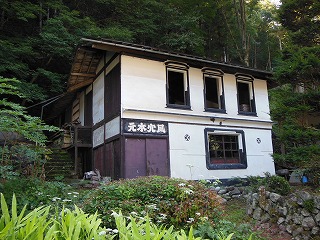 |  | ||
| 前田家表玄関 | 風穴本元 | 前田真寿美さん(右) | ||
|---|---|---|---|---|
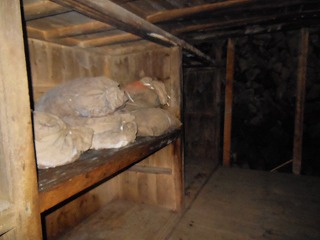 |  |  | ||
| 風穴本元の内部 | 風穴本元の内部 | 風穴本元貯蔵庫 | ||
 |
| 稲核集落の風穴マップ |
|---|
Comment:
風穴を利用した蚕の孵化調整法は稲核から全国に広まり、世界遺産になっている群馬県の「富岡製糸場と絹産業遺産群」に含まれる 蚕種貯蔵施設の荒船風穴は、稲核風穴に造られていた建物を原型にしているといわれている。
前田家の風穴「風穴本元」は、北アルプスの麓の梓川右岸を通る野麦街道(国道158号) 沿いの稲核集落にある。稲核集落の中心部で野麦街道がクランクカーブしているあたりで、嘗ては郵便局を併設していた敷地は広く、風穴もこの敷地内に ある。
風穴本元は敷地内の山側に2階建築で設置され、全国から郵送されてきた蚕種を冷蔵保存していた威容を窺がえる。稲核にある風穴は崖錐堆積型風穴の 元祖的なもので、段丘面に近い崖錐堆積物の下部に形成されている。風穴が形成されるためには崖錐堆積物を構成する岩石が充分な硬さと適度な大きさを 有している必要がある。風穴本元は崖錐堆積型風穴の元祖的なもので、冷風が吹き出す場所に石積みをして室を建てて冷風を逃がさないようにしている。 風穴本元の入口扉を開けて入ると三和土の土間で、右側に高さ20cm程の板敷床で物置になっている。板敷床の奥に頑丈な内扉があり開けて入ると、 左右両壁側と奥壁側は石垣を組んであり、隙間から冷風が吹き出ている。室内の温度計は10℃を指していた。
風穴本元の内部構造を納得ゆくまで観察させていただいた、前田真寿美さんには大変お世話になりました。深謝いたします。
The hatch adjustment method of silkworms using wind holes spread throughout the country from the Inekoki-Fuketsu, Arafne-Fuketsu in Gunma prefecture (silkworm storage facility at Tomioka Silkworms) uses the building structure of the Inekoki-Fuketsu as a prototype.
The Maeda family's Fuketsu-Honmoto is in the Inekoki village along the Nomugi-road (Route 158) passing through the Azusagawa-Right bank, Once the site that had a post office was wide, the Fuketsu (wind-hole) is also in this premises.
The Fuketsu-Honmoto was a two-story building constructed on the mountain side in the premises, refrigerated storage of the silkworm species that was mailed from the whole country.
The Fuketsu in the Inekoki is the original one of the cliff - congered deposit type the Fuketsu (wind-hole), and it is formed in the lower part of the cliff top cone near the terrace side.
The Fuketsu-Honmoto is the founder of the Fuketsu (wind-hole) reservoir, masonrying in the place where cold wind blows, to build a room so as not to let cool wind escape. Opening the entrance door and entering it is the soil of tataki, on the right side is a sheet board floor about 20 cm in height, which is a storeroom. There is a solid inner door in the back of the board, and the left and right wall sides and the back wall side combine stone walls. A cool wind is blowing out through the gap between the stone walls. The indoor thermometer points at 10℃ even in summer.
I would like to thank Mrs. Masumi Maeda for observing the internal structure of the Fuketsu (wind-hole) in detail.

名 称 : 諏訪神社境内の個人用風穴群 標 高 : 840m 場 所 : 松本市安曇稲核2701 見 学 : 2017.09.25
| [諏訪神社前〜風穴群] 諏訪神社 →00:02→ 風穴群 |
 |  | 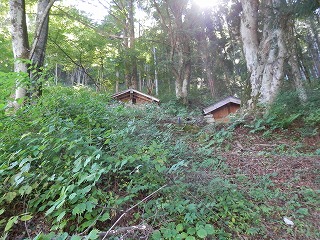 | ||
| 諏訪神社からの登り | 風穴群 | 風穴群 | ||
|---|---|---|---|---|
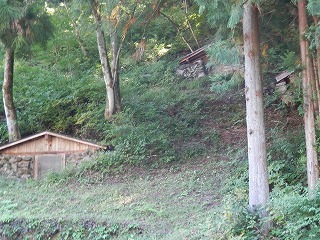 | 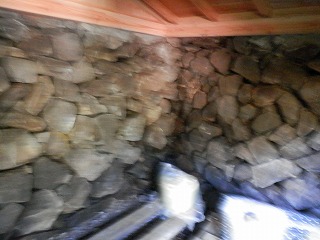 |  | ||
| 新しく建替えた風穴 | 新しい風穴内部 | 諏訪神社の水場 | ||
Comment: 前田家の風穴本元からほど遠くないところに諏訪神社がある。この神社の南西山側に崖錐斜面(梓川の河岸段丘)に10基前後の 風穴蚕種貯蔵庫ある。この風穴は個人の所有であるが、現在でも自家用の天然冷蔵庫として半数近くが使用されている。
最近改築されたものもあり、内部を見せてもらうことができ、穀物の種子、苗木、ワインの貯蔵、漬物の保存などに供せられていた。
There is a Suwa shrine in a place far from the Maeda's Fuketsu (wind-hole) headquarters. There are around ten wind-hole silkworm reservoirs on the southwestern mountain side of this shrine.
Although this wind-hole is owned by an individual, nearly half of natural refrigerators are still being used even now.
The grain seeds, seedlings, wine storage, pickles and so on were preserved inside.

名 称 : 風穴の里の風穴 標 高 : 850m 場 所 : 松本市安曇3528-1 見 学 : 2017.09.25
| [道の駅〜風穴] 風穴の里 →00:08→ 風穴 |
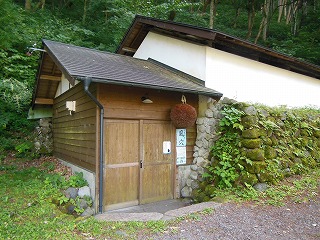 |  | 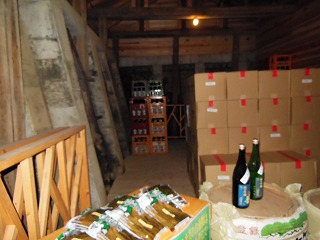 | ||
| 道の駅の風穴 | 風穴内部の石組 | 冷蔵保存品 | ||
|---|---|---|---|---|
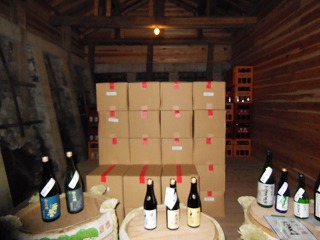 |  | 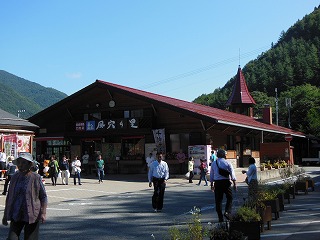 | ||
| 冷蔵保存品 | 風穴展示室 | 《風穴の里》 道の駅 | ||
Comment: 道の駅「風穴の里」から北東方向へ歩き、太鼓橋を渡り松本市安曇資料館を過ぎたあたりに見学用風穴がある。種子や苗木を 保存していた営林署の保存小屋を改築整備し直したもので、夏季でも7℃以下の温度を保っている。
見学は休日なしで、08:00 〜 17:00 の間に自由に内部に入り見学できる。風穴の里から徒歩8 min ほど、風穴の前に10台程度の駐車スペースがある。 内部には、展示説明コーナーや冷風の吹き出す石垣構造、漬物・食品・酒類などの保存状況がよく見られるように照明も整っている。児童・生徒の 学習の場としても良く考えられた設備になっている(入場料無料)。
 |
| 野麦街道沿いの稲核風穴 |
|---|
稲核風穴の近くにある VIEWPOINT
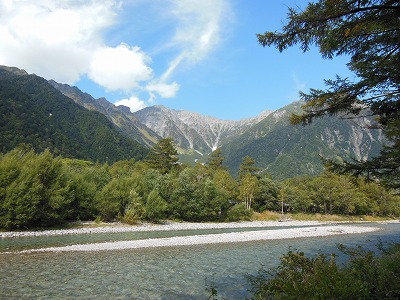 |  |
 |
| 梓川と穂高連峰 3,190 m (9/24 撮影;上高地) Azusa-river & Hotaka mountain range |
木曽駒ヶ岳 2,956 m (9/25 撮影;上松) Kiso-Komagadake |
寝覚ノ床 (9/25 撮影;上松) Nezamenotoko |
【参考文献】
・柿下愛美 大塚 勉 『信州大学環境科学年報』 34 45〜51 52〜57 2012
・仁科良夫 『長野県地学研究報告集』 3 26〜30 1983
名所旧跡案内 Miyoshi's HP